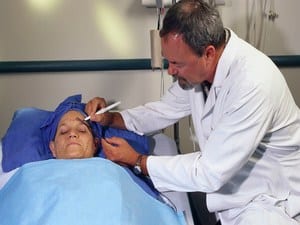
WEDNESDAY, Aug. 15, 2018 (HealthDay News) — People who choose minimally invasive cosmetic procedures do so because they want to feel good, not just look good, a new survey finds.
For the study, researchers polled roughly 500 U.S. adult patients, most of whom were white women, aged 45 and up. All had undergone some type of relatively non-invasive cosmetic procedure between 2016 and 2017.
The results revealed that nearly seven in 10 chose the procedure to improve their psychological well-being. More than half also wanted to protect their health, boost their confidence levels in a social setting, or look “professional” at work.
“Patients’ motivations for cosmetic procedures are not trivial,” said study author Dr. Murad Alam. “People who get such treatments are sensible, normal people who are not just obsessed with their appearance. They have a range of motivations.”
Alam is vice chair of dermatology at Northwestern University’s Feinberg School of Medicine, in Chicago.
Cosmetic treatments used to mean “getting traditional plastic surgery, like a face lift or tummy tuck,” he said. “These required general anesthesia, cutting and sewing the skin, significant risk of scarring, and days to weeks of recovery time.”
But, Alam explained, “More recently, dermatologists have pioneered non-invasive and minimally invasive procedures, which provide many of the same benefits as traditional plastic surgery without the risk, scars, and downtime.”
And the procedures — which range from laser treatments for brown spots to wrinkle reduction, liposuction and tattoo removal — “have become more popular than traditional cosmetic surgery,” he said.
In fact, these newer procedures accounted for the majority of the more than 7 million aesthetic services performed by U.S. dermatologists in 2016, the researchers reported.
“Interestingly and surprisingly, we found that in many cases, patients’ reasons for getting something done were different than just improving physical appearance, and more complex,” Alam added.
A personal desire “to feel happier and more confident in themselves, with overall better quality of life” was the most prevalent motivation, Alam said. “Even spouses did not influence their behavior in this regard, and they did not generally get procedures to please a spouse or significant other,” he said.
Dr. Jeffrey Janis, president of the American Society of Plastic Surgeons, said the survey “reinforces much of what plastic surgeons have learned from patients over the years.”
Janis, who also serves as executive vice chairman of the department of plastic surgery at Ohio State University’s Wexner Medical Center, said that “physical and mental well-being are strong motivating factors, as is the desire to ward off the signs of aging or delay the aging process.”
Those polled had undergone a wide range of non-invasive procedures, including laser and light treatments for brown spots, blood vessels, wrinkle reduction, scar treatment and hair removal; chemical peels; non-surgical skin tightening and fat reduction with radiofrequency energy, cold treatment, or ultrasound.
Alam said these treatments “do not even break the skin, and are applied on top of the skin.”
Minimally invasive procedures may break the skin, but just barely, he added. Those include filler and neuro-modulator injections “to fill out the sagging aging face while reducing lines and wrinkles,” alongside liposuction through tiny openings to suck out excess fat.
Age did have an impact on a patient’s choice, the poll results suggested. For example, “older patients were interested in treating the visible signs of aging that had already occurred,” Alam said. “On the other hand, patients younger than 45 were interested in being proactive to avoid or slow aging.”
Dr. Samuel Lam, a facial plastic and hair restoration surgeon in Plano, Texas, didn’t find the poll results surprising.
Minimally invasive procedures “can truly make someone look amazingly and naturally youthful and beautiful,” he said.
Yet, Lam cautioned, “as a surgeon, it is important to know what would be helpful with minimally invasive procedures, and which ones would not help at all or at times make things worse.”
Alam and his colleagues published their findings online Aug. 15 in JAMA Dermatology.
More information
The American Society of Plastic Surgeons has more on plastic surgery trends.
